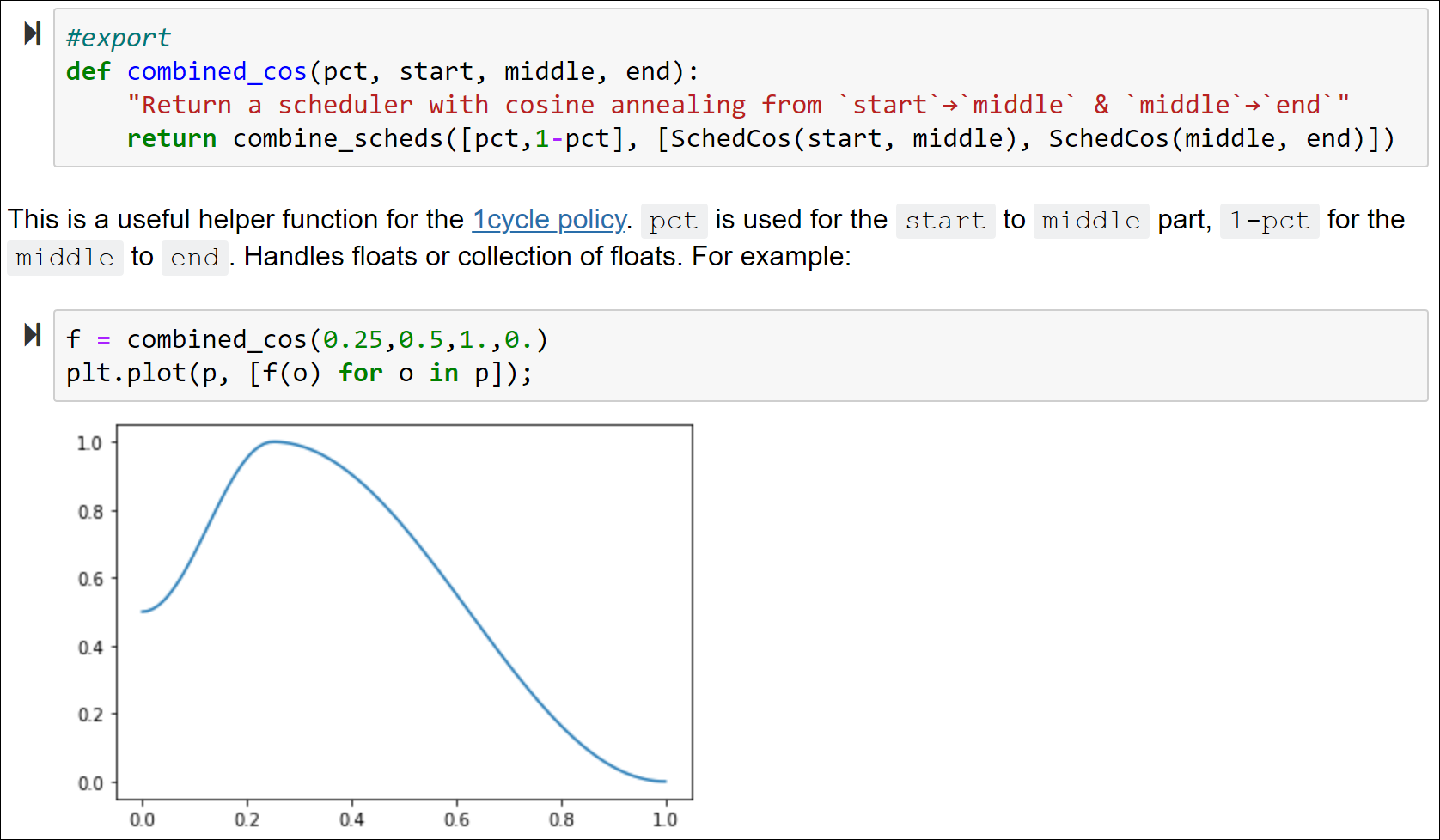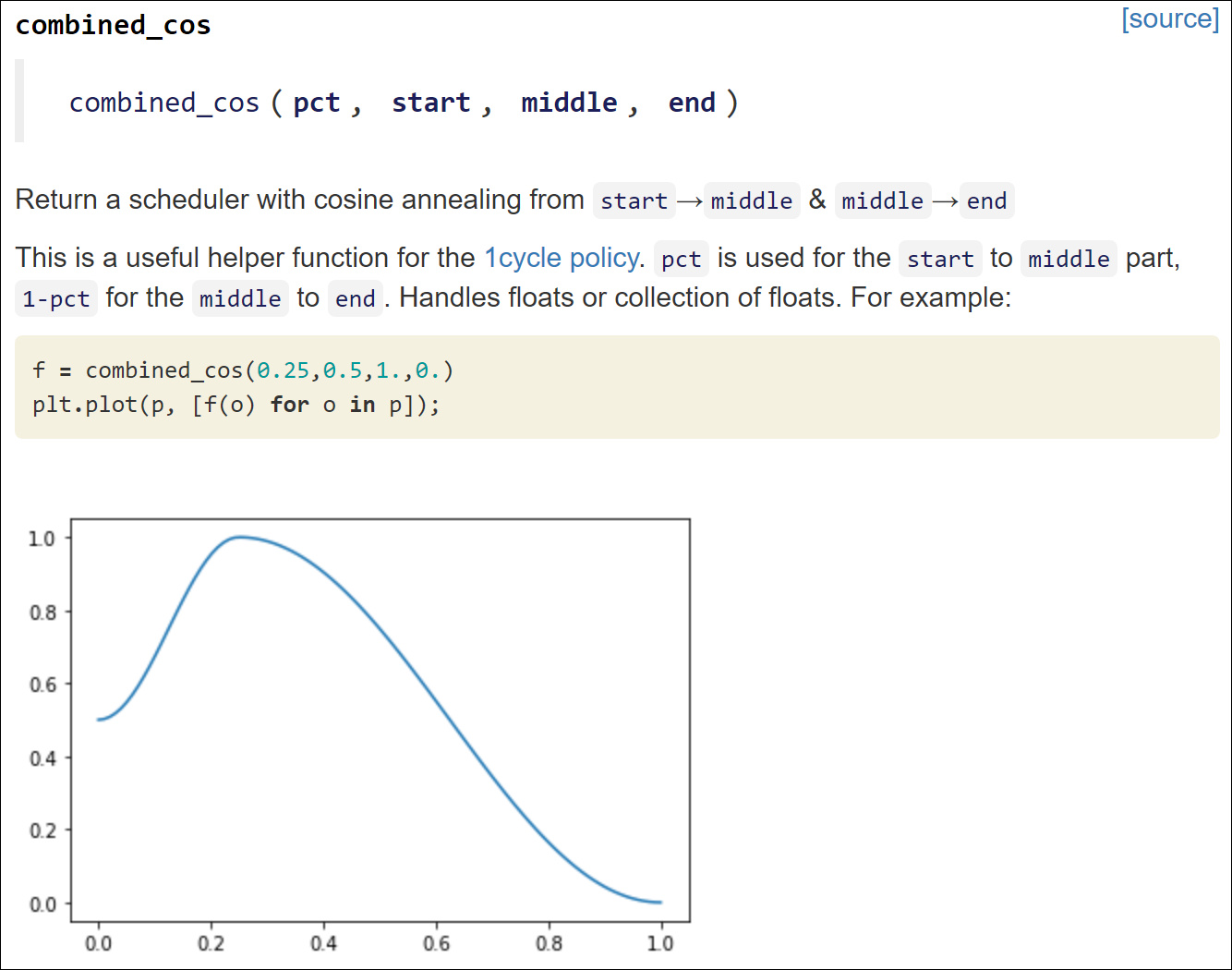Create delightful python projects using Jupyter Notebooks
nbdev is a library that allows you to fully develop a library in Jupyter Notebooks, putting all your code, tests and documentation in one place. That is: you now have a true literate programming environment, as envisioned by Donald Knuth back in 1983!
Using the interactive environment, you can easily debug and refactor your code. Add #export flags to the cells that define the functions you want to include in your python modules. Here, for instance, is how combined_cos is defined and documented in the fastai library:
Using notebooks written like this, nbdev can create and run any of the following with a single command:
- Searchable, hyperlinked documentation; any word you surround in backticks will by automatically hyperlinked to the appropriate documentation
- Python modules, following best practices such as automatically defining
__all__(more details) with your exported functions, classes, and variables - Pip installers (uploaded to pypi for you)
- Tests (defined directly in your notebooks, and run in parallel)
- Navigate and edit your code in a standard text editor or IDE, and export any changes automatically back into your notebooks
Since you are in a notebook, you can also add charts, text, links, images, videos, etc, that will included automatically in the documentation of your library. The cells where your code is defined will be hidden and replaced by standardized documentation of your function, showing its name, arguments, docstring, and link to the source code on github. For instance, the cells above are converted to:
See below for Installing and Getting Started. In the other pages of the documentation, you can get more details about:
- the export functionality from jupyter notebooks to a python library
- the cli commands you can use with nbdev in a terminal
- how export2html builds a documentation for your library
- how sync can allow you to export back from the python modules to the jupyter notebook
- how to put tests in your notebooks, which can be run in parallel, and exported to CI from your notebooks
- get more info about the additional functionality
nbdev is is on PyPI so you can just run:
pip install nbdev
For an editable install, use the following:
git clone https://github.com/fastai/nbdev
pip install -e nbdev
To begin your own project:
- click here for GitHub (you need to be logged in to GitHub for this link to work).
- click here for GitLab (you need to be logged in to GitLab for this link to work).
Fill in the requested info and click Create repository from template, and a new GitHub or GitLab repo will be created for you.
NB: The name of your project will become the name of the Python package generated by nbdev. For that reason, it is a good idea to pick a short, all-lowercase name with no dashes between words (underscores are allowed).
Now, open your terminal, and clone the repo you just created.
Alternatively, you can use a cli command nbdev_new to create a new nbdev project and initialize a git repository locally without creating a github repo.
Next, edit the settings.ini file. Note that it contains all the necessary information for when you'll be ready to package your library, so you shouldn't need to change the setup.py file provided by the template. The basic structure (that can be personalized provided you change the relevant information in settings.ini) is that the root of the repo will contain your notebooks, along with a folder docs where the doc will be auto-generated that contains everything for a jekyll-powered website. Because GitHub Pages supports Jekyll, you can host your site for free on GitHub without any additional setup.
Your settings.ini is where all parts of nbdev look for any required configuration information. Once you've edited it, run the command nbdev_build_lib (which is automatically installed for you when you install nbdev. You'll now find that you have a new directory, with the name of whatever you set lib_name to in settings.ini.
Now, run jupyter notebook, and click 00_core.ipynb. This is where you'll create your first module! Create Jupyter cells as you would in any notebook. For any cells that you want to be included in your python module, type #export as the first line of the cell. Note that for any new .ipynb that you create, you will also need to type #default_exp target_module_name, which will define the name of the generated module (lib_name/target_module_name.py).
In the last cell of your notebook, you can then run:
from nbdev.export import *
notebook2script()
Converted 00_export.ipynb.
Converted 01_sync.ipynb.
Converted 02_showdoc.ipynb.
Converted 03_export2html.ipynb.
Converted 04_test.ipynb.
Converted 05_merge.ipynb.
Converted 06_cli.ipynb.
Converted 07_clean.ipynb.
Converted 99_search.ipynb.
Converted index.ipynb.
Converted tutorial.ipynb.
Or in the command line, you can run:
nbdev_build_libas long as you are somewhere in the folder where you are developing your library. Either of these will do the same thing: update your module to include all exported cells in your notebook.
To enable documentation in your GitHub repo, click 'Settings' on the main repo page, scroll down to 'GitHub Pages', and under 'Source' choose 'master branch /docs folder'. GitHub will then show you a link to your working documentation site.
Finally, edit index.ipynb. This will be converted into your projects README file, and will also be the index for your documentation (the page you're reading right now actually comes from an index.ipynb file!) You can use the module you just exported in this library, which means you can show real working code, and actual outputs. Once you have everything as you want it, run nbdev_build_docs in the terminal. This will export HTML versions of your notebooks to the docs directory, and will create hyperlinks for any words in backticks (as long as they exist in your module). It will also create a menu for all notebooks you have created, and a table of contents for each.
If you have set the parameter nbs_path to be anything other than the project root, you will not be able to import your generated modules without an extra step:
- either install these modules locally, as their relative import will take you beyond the top-level package, which can be done by running
pip install -e .in the project root, to install the modules to your environment in editable mode. - or make a simlink in your notebook folder to the library folder, which can be done by running
ln -s lib_path lib_name(adjustlib_pathandlib_nameto your use case).
There's a lot of functionality in nbdev; see the docs for each module in the sidebar to learn about all the features. Here we'll briefly highlight a couple.
If you want people to be able to install your project by just typing pip install your-project then you need to upload it to pypi. The good news is, we've already created a fully pypi compliant installer for your project! So all you need to do is register at pypi, if you haven't previously done so, and then create a file called ~/.pypirc with your login details. It should have these contents:
[pypi]
username = your_pypi_username
password = your_pypi_password
Another thing you will need is twine, so you should run once
pip install twine
To upload your project to pypi, just type make pypi in your project root directory. Once it's complete, a link to your project on pypi will be printed.
NB: make sure you increment the version number in settings.py each time you want to push a new release to pypi.
Jupyter Notebooks can cause challenges with git conflicts, but life becomes much easier when you use nbdev. As a first step, run nbdev_install_git_hooks in the terminal from your project folder. This will set up git hooks which will remove metadata from your notebooks when you commit, greatly reducing the chance you have a conflict.
But if you do get a conflict, simply run nbdev_fix_merge filename.ipynb. This will replace any conflicts in cell outputs with your version, and if there are conflicts in input cells, then both cells will be included in the merged file, along with standard conflict markers (e.g. =====). Then you can open the notebook in Jupyter and choose which version to keep.
You can use GitHub actions to leverage the functionality of nbdev and easily make a CI that:
- check the notebooks are readable (with
nbdev_read_nbs) - check the notebooks have been cleaned of needless metadata to avoid merge conflicts (with
nbdev_clean_nbs) - check there is no diff between the notebooks and the exported library (with
nbdev_diff_nbs) - run the tests in your notebooks (with
nbdev_test_nbs)
The template contains a basic CI that uses the four points above, edit the file .github/workflows/main.yml to your liking and comment out the parts you don't want.
nbdev supports equations (we use the excellent KaTeX library). Enable it with use_math: true in your _config.yml (it's enabled by default). You can include math in your notebook's documentation using the following methods.
Using $$, e.g.:
{% raw %}
$$\sum_{i=1}^{k+1}i$$
{% endraw %}
Which is rendered as:
$$\sum_{i=1}^{k+1}i$$
Using $, e.g.:
This version is diplayed inline: $\sum_{i=1}^{k+1}i$ . You can include text before and after.
Which is rendered as:
This version is diplayed inline:$\sum_{i=1}^{k+1}i$ . You can include text before and after.
For adding search to your docs site, nbdev supports Google Custom Search, including auto-completion as you type your search query. You can try it out by using the search box at the top of this page.
Although we can't fully automate the creation of the search engine (since you need to login to Google to do it) we have made it very easy. Here are the steps you need to follow: Setting up search.
If you want to contribute to nbdev, be sure to review the contributions guidelines. This project adheres to fastai`s code of conduct. By participating, you are expected to uphold this code. In general, the fastai project strives to abide by generally accepted best practices in open-source software development.
Make sure you have the git hooks we use installed by running
nbdev_install_git_hooks
in the cloned repository folder.
Copyright 2019 onwards, fast.ai, Inc. Licensed under the Apache License, Version 2.0 (the "License"); you may not use this project's files except in compliance with the License. A copy of the License is provided in the LICENSE file in this repository.

